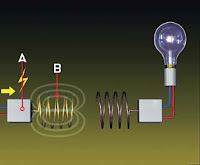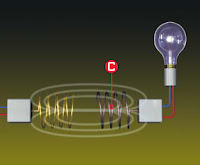With the onslaught of wireless devices, it was only a matter of time before electricity goes wireless as well. Although Scientists have known for years how to transmit electricity without wires, the distance range has been limited. However, last year a team at the Massachusetts Institute of Technology set a new standard by accessing power that works from across a room. The scientists at MIT successfully powered a 60-watt lightbulb from a power source 7 feet away by using magnetic induction and two identical copper coils that resonate at the same frequency. Here is quick look at how the process works:

Step One:
A circuit [A] attached to the wall socket converts the standard 60-hertz current to 10 megahertz and feeds it to the transmitting coil [B]. The oscillating current inside the transmitting coil causes the coil to emit a 10-megahertz magnetic field.
Step Two:
The receiving coil [C] has the exact same dimensions as the sending coil and thus resonates at the same frequency and, in a process called magnetic induction, picks up the energy of the first coil’s magnetic field.
Step Three:
The energy of the oscillating magnetic field induces an electrical current in the receiving coil, lighting the bulb [D].